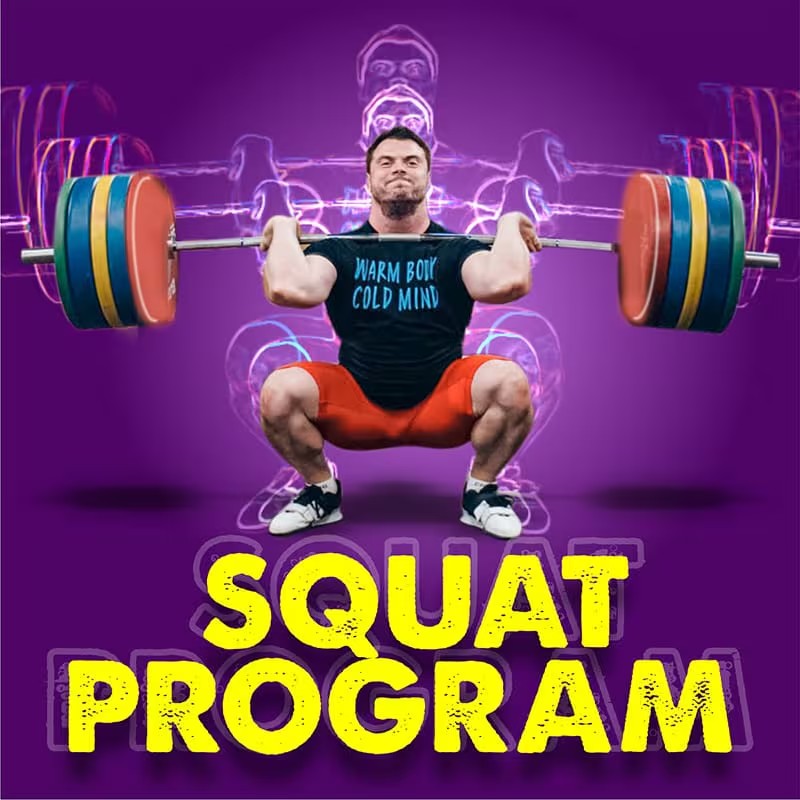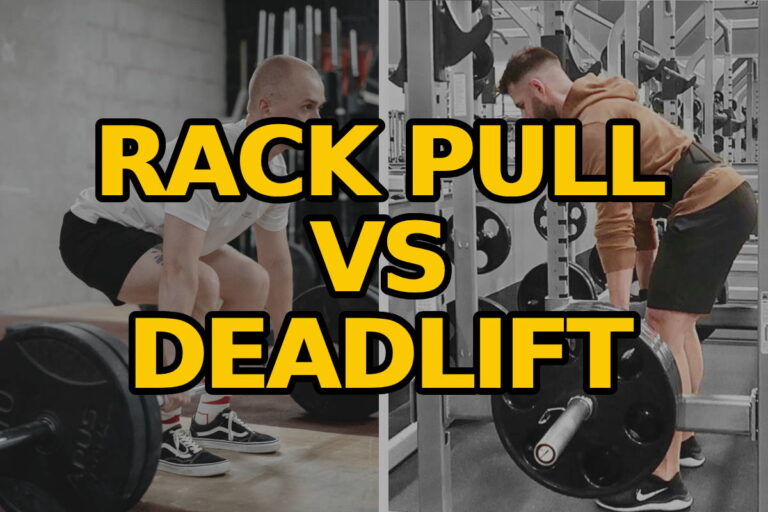High Bar vs Low Bar Squat: Which Is Best For You?
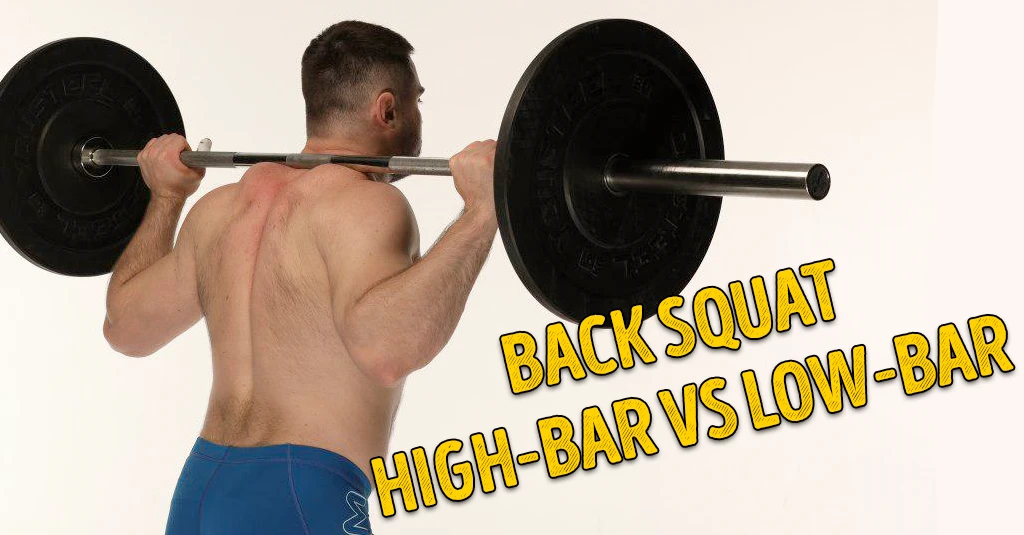
This article also available as audio. Check this out!
Subscribe and listen it anywhere:
In this article, we will look at the high bar vs low bar squat. Find out the difference between high bar and low bar squat to choose your best position.
When I was asked about high bar vs low bar squat in my seminar for the first time, I was surprised as no weightlifters I know have ever practiced the low-bar back squat.
Nevertheless, many athletes are trying to implement this squat technique in their training, because they’ve heard a word from the strength athletes that bigger weights could be lifted that way. Thus, they try to push their snatch and clean & jerk progression by using this technique.
In this article, we will try to figure out the difference between high bar and low bar squat. Let’s get down to business!
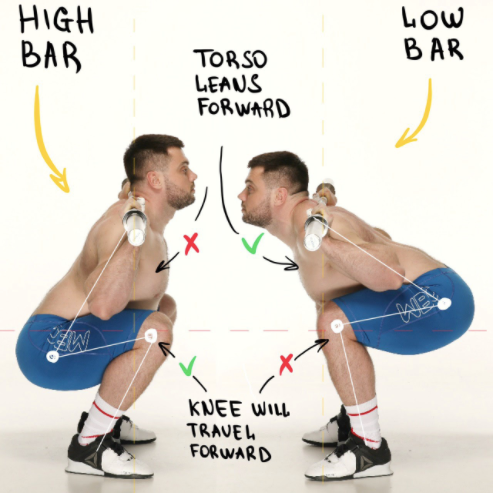
High bar vs low bar squat. The main difference between high bar vs low bar squat is the bar placement on the shoulders. In the first technique, you put a bar on the traps, and the second one shifts it 4-6 cm lower to the level of the rear delts and shoulder joint center.
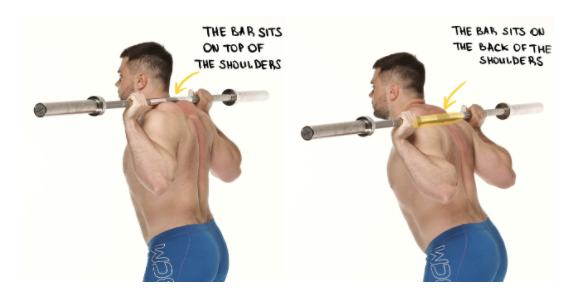
What Is a High-Bar Squat?
The high-bar squat is the most basic and popular exercise in the gym. The first part of its name just emphasizes the bar placement on the shoulders.
Such a technique has some differences in the outcome as well. It allows you to direct most of the tension to your quads and takes some load away from the lower back. Additionally, this position lets you squat deeper. Generally, it is a more natural way to perform this exercise.
As for the downsides, it puts more stress on your knees. As the trunk is in a more vertical position and your hips go down rather than back, you have to drive your knees forward to perform the move. You can also find high-bar squats somehow uncomfortable if you lack ankle mobility
Another disadvantage is that such mechanics may limit your strength capacity. A lot of athletes find it harder to squat a huge weight with such a technique. Nevertheless, some experienced powerlifters stick to this bar position even at competitions. Thus, it is a very individual issue.
High-Bar Squat Technique
Place a barbell on your traps and take it off the racks. While doing that, keep both of your legs in the same line to keep the balance and prevent injuries, don’t unrack weights with one leg forward.
Step backward, take a deep breath, open the chest, and look straight ahead. Tense your back and core muscles to stabilize the torso. Squat down till you reach the desirable depth (usually athletes go down to the very hole of the squat).
Keep your trunk upright, move the hips down, and don’t lean forward too much. Once you are in the lower position, go up immediately, don’t make any pauses in the hole. Return to the starting position and fix the weight. Don’t drive your hips forward, keep the core tight and stable.
Perform up to 10 reps, depending on your level, kind of sport, and training goals. Return the bar to the racks.
Who Should Perform the High-Bar Squat?
The high-bar squat is the basic movement for Olympic lifts and functional fitness athletes, who perform the majority of their basic exercises, such as the snatch, clean, etc., with a more upright posture.
Additionally, any athlete who wants to boost their quads or strengthen core muscles should perform high-bar squats. This exercise is also great for those who want to avoid extra lower back tension.
As for competitive squats, practice usually shows that athletes with relatively short legs tend to squat heavier while using the high-bar technique while tall lifters often struggle to maintain the proper mechanics.
What Is a Low Bar Squat?
The low-bar squat is another squat technique. The key difference is the bar placement which shifts down by 4-6 cm to the rear delts.
Such a position allows you to direct most of the load to the posterior chain – the hamstrings, glutes, and back. Obviously, it activates more muscles and spreads the weight more evenly. Therefore, you can often generate more strength and handle heavier weights by following this technique.
The main difference in the technique is a prominent torso lean. It helps to distribute the load equally but at the same time puts more tension on the lower back. On the other hand, you drive your hips backward and maintain your shins more vertical, preventing the knees from going forward, thus, taking the extra load away.
Additionally, low-bar squats are less demanding in terms of ankle mobility. Such a technique doesn’t require you to go that low, most athletes aim to put their hips parallel to the ground.
Because of all these mechanical peculiarities, low-bar squats usually allow you to handle a bigger weight. Thus, most athletes perform the squat at the competition by following this technique.
Finally, the low-bar squats really grant you the possibility to put more weight on the barbell, but it doesn’t mean that you grow much stronger than while performing squats with the high-bar position.
The low-bar squat provides some advantages in lever length and muscle involvement thus making squats with a bigger weight easier at these “certain angles”. It is important to keep in mind that if you can’t handle the weight with the high-bar position, but can do it with the low-bar position, then the reason is the lack of torso strength and stability rather than leg muscle weakness.
Low-Bar Squat Technique
Grab a bar at the shoulder width and place it at the rear delts. Squeeze the shoulder blades and unrack the bar. Take one step back and set up the starting position.
Open the chest, look straight ahead, and take a deep breath, tightening the core muscles. Drive your hips backward, stretching the hamstrings. As you move down, lean forward to keep the gravity center at the mid-foot.
Don’t go too low and don’t allow the ‘butt wink’. For most athletes, placing their hips parallel to the ground feels the most optimal.
Return to the starting position. During the ascent, keep your back arched and tight as well as your abs. Exhale on the way up or as you reach the upper point.
Perform up to 10 reps, depending on the weight and your training goals.
Who Should Perform the Low-Bar Squat?
The low-bar back squat gives more potential to lift a maximum weight, that’s why this technique is mainly used by powerlifters, strongmen, and partially bodybuilders. Additionally, athletes who want to target their posterior chain can stick to this position.
If you compete in squats, you should also choose the most beneficial bar placement for you. Usually, tall athletes find it more effective to stick to the low-bar technique.
Low Bar Squat vs High Bar Squat
Low-bar and high-bar squats differ in barbell placement, mechanics, load distribution, and their outcomes. If you want to squat with the most benefit for your physique and results, you should analyze your sport, training needs, and body peculiarities.
I will try to simplify everything for you by explaining the key differences to consider. Let’s take a closer look and compare the 4 main features of both squat techniques.
1. Torso Load Distribution and Balance
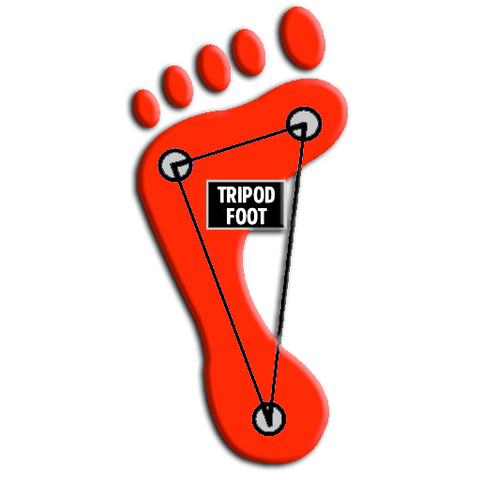
The athlete must keep the balance on his mid-foot during the squat regardless of the technique. The main rule is to keep thrust distributed on the heel and big and little toes. You can probably imagine what’s going to happen if the athlete excessively shifts his gravity center either to the balls of his feet or to his heels.
In the high-bar position, the barbell is located generally higher. Such bar placement creates a longer lever increasing the chance for the athlete to curve his back or lose his stable and safe posture if he happens to go off balance. That’s why strong back muscles and solid torso stabilization is required for the high-bar technique.

First of all, an athlete must keep the balance on their mid-foot during the squat, regardless of the technique. The main rule is to keep the thrust distributed between the heel and big and little toes. You can probably imagine what’s going to happen if an athlete excessively shifts the gravity center either to the balls of the feet or to their heels.
In the high-bar position, the barbell is located generally higher. Such bar placement creates a longer lever increasing the chance for an athlete to curve their back or lose their stable and safe posture if they happen to go off balance. That’s why strong back muscles and solid torso stabilization is required for the high-bar technique.
As you can see in the pictures, the high-bar position requires you to keep the torso more vertical to maintain the proper gravity canter, weight distribution, and overall mechanics.
In the low-bar position, the barbell is located much lower, which makes the torso lever shorter. This is the reason why this technique allows us to lift bigger weights. Yet, such a technique makes you lean forward to keep the balance and proper angles.
2. Torso position.
Each squat requires a specific torso position to provide proper foot balance and weight distribution.
In the high-bar position, the athlete’s posture is more upright, knees move forward and hip joints move lower. This type of squats demands you to have really strong core muscles to maintain a vertical posture.
In the low-bar position, the athlete has to do a deeper leaning forward to keep their balance. Such a technique puts more load on your lower back, though.
3. Flexibility and mobility.
For the high-bar position, maximum mobility and bending in the knee and ankle joints are necessary. If the range of motion in these joints is limited then the high-bar position may become uncomfortable. It might be a good tool to develop mobility, though.
The low-bar position is much easier for athletes with a low range of motion in the ankles, as the hip joint angle is maximally acute while the ankle remains almost perpendicular to the platform. Nevertheless, more specific shoulder joint mobility is required for the safe and steady barbell position on the back.
4. Muscles activation.
The differences in muscle work in different barbell positions haven’t been well studied yet. But athletes that experienced both of these techniques tell about different sensations in how the muscles work.
In the high-bar position, more knee bend happens and more anterior thigh muscles (especially quadriceps) become involved in the movement.
In the low-bar position, the torso is more inclined forward, and this involves all posterior thigh muscles, especially hamstrings and glutes. Quadriceps work quite well, too. Additionally, such a technique provides a significant load for your back muscles.
Obviously, the more muscles you involve, the more weight you can handle. Usually, this rule works in the squat, too, however, you should also consider your body structure peculiarities.
🔻12 Week Squat Program by Oleksiy Torokhtiy
Do you want to double your squat strength? In just 12 weeks, you’ll be able to boost your squat results.
This program transforms any ordinary squat into a powerful athletic movement.
What’s included:
- 12 weeks of squat programming;
- Effective combination of sets, reps, and weights;
- Fully designed and coached by Oleksiy Torokhtiy;
- Over 60+ movements, banded work, and weight training;
- Accessory work for core, joint stability and injury prevention;
- Max out on back squat and front squat at the end.
Start now and boost your squat results!
FAQ
Does a low bar make you squat more?
Generally, the low-bar technique really allows you to squat more weight due to higher muscle activation. Still, it doesn’t work equally well for all athletes. Some professional powerlifters prefer the high-bar position to compete. It all depends on your body peculiarities and muscle development.
Why is the low bar stronger than the high bar?
Low-bar squats allow you to spread the weight more evenly throughout all the muscles and have some benefits in the lever length. Also, they are less demanding in terms of ankle mobility and shorten the overall amplitude.
Is a low bar better for long legs?
The low-bar position can really be more effective for long legs in terms of mechanics and strength capacity. It makes your hips go far backward and provides more flexion, allowing them to generate more force.
Are low bar squats better for knees?
Low-bar squats maintain your shins more vertical, keeping the knees from traveling forward. Such mechanics really decreases the joint load and is more comfortable for those who feel any discomfort while high-bar squatting.
So What Is Better: Low Bar vs High Bar Position?
Classic high-bar Olympic squats are perfect to strengthen both the torso and legs. And core stability is an indispensable part of every strength, speed, or functional exercise. Still, it is up to you to choose the bar position.
We have programs that focus on strength development or working out major muscle groups for functional fitness athletes and weightlifters. Well-balanced loadings and the whole array of necessary exercises will provide you with the best results possible. Check out the special offer on our strength programs on this page.
Why Trust Us?
With over 20 years in Olympic Weightlifting, our team does its best to provide the audience with ultimate support and meet the needs and requirements of advanced athletes and professional lifters, as well as people who strive to open new opportunities and develop their physical capabilities with us.
By trusting the recommendations of our certified experts in coaching, nutrition, dietology, and sports training programming, as well as scientific consultants, and physiotherapists, we provide you with thorough, well-considered, and scientifically proven content. All the information given in the articles concerning workout programming, separate exercises, and athletic performance, in general, is based on verified data. We ensure that you can rely on our professionals’ pieces of advice and recommendations that can be treated as personalized ones which will benefit you and fully meet your needs.
The product testing process is described in more detail here
Author: Sergii Putsov
Head of Sport Science, PhD
Best Results: Snatch – 165 kg,
C&J – 200 kg
Sergii Putsov, Ph.D., is a former professional weightlifter and National team member, achieving multiple medals in the 94 kg weight category at national competitions. With a Master’s degree in “Olympic & Professional Sport Training” and a Sport Science Ph.D. from the International Olympic Academy, Greece, Sergii now leads as the Head of Sport Science. He specializes in designing training programs, writing insightful blog articles, providing live commentary at international weightlifting events, and conducting educational seminars worldwide alongside Olympic weightlifting expert Oleksiy Torokhtiy.






